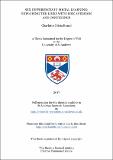Files in this item
Sex differences in social learning : exploring the links with risk aversion and confidence
Item metadata
| dc.contributor.advisor | May, Robert Catharine | |
| dc.contributor.advisor | Brown, Gillian R. | |
| dc.contributor.author | Brand, Charlotte Olivia | |
| dc.coverage.spatial | 196 p. | en_US |
| dc.date.accessioned | 2018-03-22T16:50:36Z | |
| dc.date.available | 2018-03-22T16:50:36Z | |
| dc.date.issued | 2017-06-20 | |
| dc.identifier.uri | https://hdl.handle.net/10023/13001 | |
| dc.description.abstract | In this thesis, I explore sex differences in adult human social learning, and how these sex differences might be underpinned by differences in risk-taking and confidence. The capacity for high-fidelity social learning is fundamental to the complex culture observed in humans. Examining when we choose to learn socially rather than asocially and the factors that influence these choices is valuable for understanding broader patterns of cultural evolution. In Chapter 1, I give an overview of the literature on sex differences in social learning, particularly how individual differences in risk-taking and confidence impact upon social information use. I introduce stereotype threat as a possible factor affecting women’s confidence. I then use the stereotype threat literature as an example of the replication crisis in psychology, and discuss how improved methods of statistical analysis could help to elucidate the ambiguity in this literature. Chapter 2 provides an experimental investigation into when adult humans choose to use social or asocial information to solve a virtual construction task. I found that when the asocial information was made to be risky, women, but not men, preferred to learn socially. In Chapter 3, I present experimental data exploring the links between confidence and conformity. I found that lower confidence led to a greater likelihood of conforming, although I was unable to reliably alter confidence levels experimentally. In Chapter 4, I present a model of the stereotype threat literature by simulating numerous datasets and analysing them using four different statistical methods. I found that using informative priors in a Bayesian framework provided greater certainty about the presence or absence of an effect in a population. Finally, in Chapter 5 I conclude that studying the factors that lead to sex differences in social learning provides researchers with a greater understanding of the dynamics of cultural evolution. | en_US |
| dc.language.iso | en | en_US |
| dc.publisher | University of St Andrews | |
| dc.rights | Attribution-NonCommercial-NoDerivatives 4.0 International | * |
| dc.rights.uri | http://creativecommons.org/licenses/by-nc-nd/4.0/ | * |
| dc.subject | Sex differences | en_US |
| dc.subject | Social learning | en_US |
| dc.subject | Cultural evolution | en_US |
| dc.subject | Evolution of human behaviour | en_US |
| dc.subject | Confidence | en_US |
| dc.subject | Risk taking | en_US |
| dc.subject | Stereotype threat | en_US |
| dc.subject | Bayesian statistics | en_US |
| dc.subject.lcc | HQ783.B8 | |
| dc.subject.lcsh | Social learning--Sex differences | en |
| dc.subject.lcsh | Risk-taking (Psychology)--Sex differences | en |
| dc.subject.lcsh | Confidence--Sex differences | en |
| dc.title | Sex differences in social learning : exploring the links with risk aversion and confidence | en_US |
| dc.type | Thesis | en_US |
| dc.contributor.sponsor | University of St Andrews | en_US |
| dc.contributor.sponsor | Templeton Foundation | en_US |
| dc.type.qualificationlevel | Doctoral | en_US |
| dc.type.qualificationname | PhD Doctor of Philosophy | en_US |
| dc.publisher.institution | The University of St Andrews | en_US |
The following licence files are associated with this item:
This item appears in the following Collection(s)
Except where otherwise noted within the work, this item's licence for re-use is described as Attribution-NonCommercial-NoDerivatives 4.0 International
Items in the St Andrews Research Repository are protected by copyright, with all rights reserved, unless otherwise indicated.


